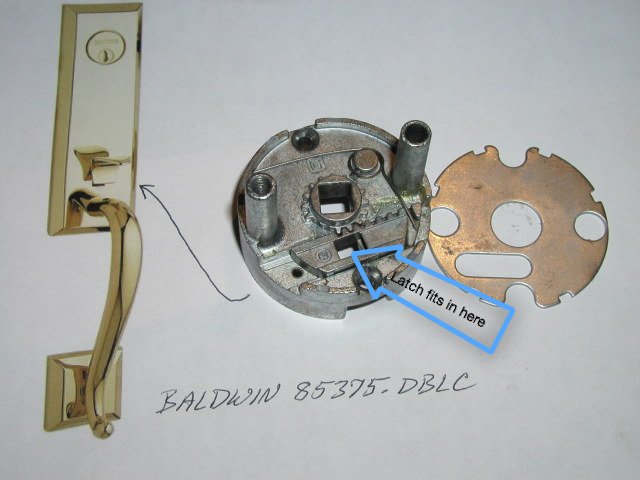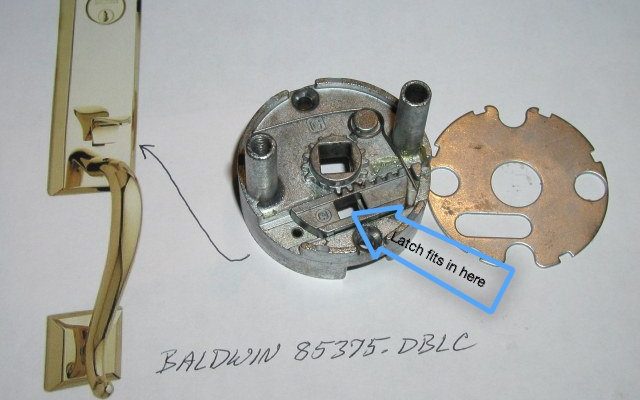
Honestly, it’s a super common problem, whether you have a single-cylinder deadbolt, a fancy electronic lock, or even a universal kit. If the handleset moves at the top, it usually means something’s not tightened right or a part inside the door has worn out. In this article, I’ll walk you through the reasons this happens, simple troubleshooting steps, and what you can do to keep your door handle solid and dependable—without calling in a locksmith unless you really have to. Grab a screwdriver; we’re getting hands-on.
How Handleset Top Mounts Work (And Why They Get Loose)
Let me explain what’s actually holding your door handle in place. Most handlesets—the kind with a thumb latch at the top and a pull handle beneath—use a mounting screw or bracket that connects the top of the exterior handle to the inside of the door. Think of it as the “anchor” point. When you pull or push the handle, that top connection absorbs a lot of the force. Over time, the constant opening, closing, and even small vibrations can work the mount loose.
There are a few different designs out there:
- Through-bolt mounts—A long screw goes straight through the door, connecting the outside handle to a plate or cap on the inside.
- Wood screw mounts—Some brands use a short, fat screw that simply bites into the wood of the door itself. Quick to install, but more likely to loosen up.
- Hidden bracket systems—Especially on newer, sleeker handlesets, you might see a clip or bracket inside the door that needs to be snapped or screwed into place.
Here’s the thing: any handleset, no matter the brand or type, can get loose at the top if the connection isn’t rock-solid. If you notice a gap, rattling, or movement, it’s usually because the screw has backed out, the wood has worn down, or the internal bracket is bent or broken.
Common Causes of a Loose Handleset Top Mount
You might be wondering, “Why would my handleset suddenly loosen up after years of working perfectly?” There are a handful of usual suspects:
- Vibration and repeated use—Every time the door slams or even closes gently, those little vibrations can nudge screws loose over months or years.
- Temperature and humidity changes—Wood doors expand and contract. That movement can slowly pull screws out of their holes or weaken brackets.
- Poor installation—If the original screws weren’t tight enough, or the installer skipped a step, you’re more likely to see problems sooner.
- Wear and tear on internal parts—Sometimes, the bracket or mounting plate inside gets bent, stripped, or even cracked—especially if you’ve had to force the door or the handle sticks.
Think about it like your favorite pair of jeans: even if they fit perfectly at first, a little daily stretching and movement can make the waistband loose or the fabric wear thin. And if you try to “fix” them with a quick tug or a cheap belt, you’re just covering up the problem, not solving it.
How to Check If the Handleset Top Mount Is Loose
Before you start unscrewing things, you’ll want to confirm the *real* source of the looseness. A lot of people assume the problem is the lock or the main handle, but it’s surprisingly common for only the top mount to wiggle.
Here’s what to do:
- Test the handle movement—Grab just the top of the exterior handle and gently push and pull. If you feel it shift but the bottom stays still, it’s almost certainly the top mount.
- Look for visible gaps—Check where the top of the handle meets the door. If you can see daylight or wiggle the handle enough to make a gap, that’s your trouble spot.
- Examine the mounting screw or bolt—Some brands (like Schlage or Yale) have a visible screw at the top, while others hide it under a cap. Look for signs the screw is loose, missing, or crooked.
If the entire handle moves as a unit, or you see the deadbolt wiggling too, you may have a bigger issue with the lockset as a whole. But if it’s just the top, you’re looking at a classic loose top mount.
Step-by-Step: Tightening a Loose Handleset Top Mount
Honestly, fixing this is usually a DIY job, even if you’ve never touched a lock before. Here’s a slow, careful walkthrough so you don’t miss a step.
- Find the mounting screw—On most designs, there’s a small screw or cap at the very top of the handle, either visible or hidden under a decorative cover.
- Remove the cover (if needed)—If there’s a cap, gently pry it off with a flat screwdriver or even your fingernail. Don’t force it; it should pop free with a little pressure.
- Tighten the screw—Use the right size Phillips or flathead screwdriver. Turn the screw firmly, but don’t go full Hulk—over-tightening can strip the threads.
- Check the fit—After tightening, test the handle for movement. Still loose? The screw hole or bracket inside the door might be stripped or damaged.
- Reinstall the cover—Snap or screw the decorative cap back in place.
If the screw just spins or won’t grip, you may need to upgrade to a slightly larger screw, or use a wood filler and re-drill the hole. There’s no shame in improvising a little—sometimes, the official “fix” isn’t as sturdy as a creative solution.
What to Do If the Hole or Bracket Is Stripped
Here’s where things get tricky. If you’ve tightened the screw and it keeps coming loose—or it won’t tighten at all—you’re probably dealing with a stripped hole or a worn bracket. This happens when the screw has chewed up the wood inside the door, or the internal bracket has bent or lost its threading.
At this point, you have a few choices:
- Try a longer or wider screw—Sometimes, simply swapping in a beefier screw will let you dig into fresh wood and make a tighter connection.
- Use wood filler or toothpicks—Pack the hole with wood glue and toothpicks or use a purpose-made wood filler. Let it dry, then re-insert the screw. It’s an old carpenter’s trick, but it works surprisingly well.
- Replace the bracket—If your lock uses a metal bracket and it’s bent or stripped, check with the manufacturer. Many brands like Kwikset sell replacement parts. If it’s a universal style, you may find a generic bracket at the hardware store.
Don’t get discouraged if you have to try a couple of fixes. The inside of a door isn’t always pristine, especially in older homes. Take it slow, and remember: a snug screw today means a sturdy handle tomorrow.
When to Call a Pro vs. DIY
Let’s be real—not everyone wants to mess with door hardware, and that’s okay. Most top-mount issues on a handleset are 100% fixable with basic tools, but there are times when it’s smart to call in backup.
- The handle is still loose after multiple fixes—If you’ve tried wood filler, new screws, and even replaced the bracket, it could mean the door material itself is too worn or the handleset is faulty.
- The lock isn’t working right—If you notice the deadbolt or latch no longer lines up, or the key won’t turn smoothly, the problem might be deeper than just the top mount.
- Your handleset is a specialty or electronic model—Some smart locks or designer handles require specific tools or programming (like code sync or electronic reset). Messing with these can sometimes void the warranty, so double-check your manual or the brand’s website first.
Honestly, most people can fix a loose top mount themselves. But if you’re ever worried about damaging the lock, compromising your security, or just getting in over your head, there’s no shame in calling a locksmith.
Preventing Future Handleset Top Mount Problems
You’ve got the problem sorted out, but how do you keep your handleset from loosening up again? Good news: a little maintenance goes a long way.
- Check the screws every few months—Make it a habit to give your handles a quick wiggle. If you feel any movement, nip it in the bud with a screwdriver.
- Watch for door swelling or shrinking—If you live somewhere with big temperature swings or humidity, keep an eye on your door. A stuck or dragging door can put extra pressure on your handleset, so adjust weatherstripping or sand sticky spots as needed.
- Lubricate the moving parts—A little graphite or silicone spray in the keyhole and latch keeps things moving smoothly. Avoid WD-40 or oil, which can gum up over time.
- Upgrade your mounting hardware—If you’ve had recurring issues, consider swapping out the wood screws for through-bolts or a heavy-duty bracket. A universal kit from the hardware store can add stability—no matter what brand you start with.
It’s a bit like tightening the legs on a wobbly table—not glamorous, but totally worth it for peace of mind.
Comparing Handleset Mounting Styles: Universal vs. Brand-Specific
Not all handlesets are created equal. Some use universal parts that fit almost any door, while others—from brands like Schlage, Kwikset, or Yale—are designed with proprietary mounting systems. So, which is better for avoiding loose top mounts?
- Universal handlesets—These usually come with a range of screws, brackets, and mounting options. Great for flexibility, but sometimes the fit isn’t as tight, especially if your door is a bit wonky or off-standard.
- Brand-specific handlesets—These are tailored for specific door thicknesses and mounting styles. They often include through-bolt designs, which hold up better long-term but can be trickier to install or repair.
- Smart or electronic models—With more parts and programming, troubleshooting a loose mount can get a little weird. Some require a sync or code reset if you detach key parts, so always check the instructions first.
If you’re replacing a loose handleset, it’s worth matching the style to your door for the most secure fit. Sometimes, a universal part works in a pinch, but if your handle keeps loosening up, going with the original brand hardware is usually the safest bet.
Wrapping Up: A Secure Handleset Means a Happier Home
A loose handleset top mount might seem like a small thing, but it’s one of those little annoyances that can snowball into bigger problems if you ignore it. The good news is, you can usually troubleshoot and fix it yourself—no fancy skills or expensive tools needed. Whether you’re tightening a screw, swapping brackets, or just doing a quick maintenance check, keeping your door handle snug means better security and a smoother welcome every time you come home.
Take a few minutes to give your handleset a gentle checkup, and you’ll save yourself frustration down the road. And if you run into trouble you can’t solve, there’s always a pro ready to help. A solid door handle—it’s the unsung hero of your home’s everyday comfort and safety.
